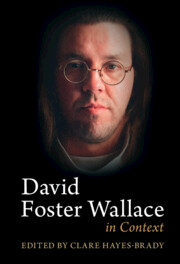Book contents
- David Foster Wallace in Context
- David Foster Wallace in Context
- Copyright page
- Contents
- Figures
- Contributors
- Acknowledgments
- Abbreviations
- Introduction
- Part I Contexts
- Part II Ideas
- Part III Bodies
- Chapter 20 No Ordinary Love
- Chapter 21 “The Limits of His Seductively Fine Mind”
- Chapter 22 David Foster Wallace and Masculinity
- Chapter 23 Theorizing the Other
- Chapter 24 David Foster Wallace and Disability
- Chapter 25 Queering Wallace
- Part IV Systems
- Works by David Foster Wallace
- Bibliography of Secondary Sources
- Index
Chapter 21 - “The Limits of His Seductively Fine Mind”
Wallace, Whiteness and the Feminine
from Part III - Bodies
Published online by Cambridge University Press: 18 November 2022
- David Foster Wallace in Context
- David Foster Wallace in Context
- Copyright page
- Contents
- Figures
- Contributors
- Acknowledgments
- Abbreviations
- Introduction
- Part I Contexts
- Part II Ideas
- Part III Bodies
- Chapter 20 No Ordinary Love
- Chapter 21 “The Limits of His Seductively Fine Mind”
- Chapter 22 David Foster Wallace and Masculinity
- Chapter 23 Theorizing the Other
- Chapter 24 David Foster Wallace and Disability
- Chapter 25 Queering Wallace
- Part IV Systems
- Works by David Foster Wallace
- Bibliography of Secondary Sources
- Index
Summary
I see feminism as a commitment to the full humanity of all women and all men, and a dismantling of the patriarchal values that inhibit this.
My essay is interested in David Foster Wallace’s complex and evolving relationship with feminism and the feminine, as well as in how this relationship has been figured over time within the literary community. This investigation involves an account of how critical practices surrounding Wallace have transformed over the past decade—from readings that take as universal the “human being” of Wallace’s work, instead of reading it as emblematic of a particular nexus of privileged observer-positions, to intersectional readings that acknowledge Wallace’s embodiment as a white middle-class American male whose work reflects that embodiment in important ways, to, finally, #MeToo-era readings that foreground the actual misogynistic violence inflicted by Wallace in his personal capacity, which, morally and politically, would seem to foreclose the possibility of further reading and set up an existential crisis for the burgeoning field of Wallace Studies.
As I engage with each of these critical approaches in my essay, three central questions emerge. First: How has the history of feminism in America shaped Wallace’s work and its reception? Second: If feminism is “a commitment to the full humanity of all women and all men,” where does Wallace’s empathy expand in this regard and where does it break down, on the page and in the flesh? Third: In our present historical moment, does acknowledging Wallace’s ultimate betrayal of this commitment in the form of his abuse mean a complete disavowal of the author and the man—an end to the conversation, as it were—or is there space for the #MeToo movement within Wallace Studies?
Keywords
- Type
- Chapter
- Information
- David Foster Wallace in Context , pp. 225 - 235Publisher: Cambridge University PressPrint publication year: 2022



